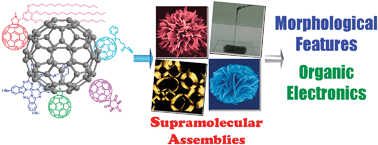Self-organisation is an elegant tool for the creation of assemblies controlled in all dimensions with tunable properties in natural as well as artificial supramolecular systems. Especially, the supramolecular organisation of fullerene (C60) using π-stacking interaction to form various functional assemblies is of particular importance as it can provide excellent optoelectronic properties. Interestingly, the insufficient solubility of C60 has been overcome through the noncovalent interaction with other hosts and covalent functionalisation with organic moieties. This has resulted in supramolecular assemblies at the nano/micro/macro scales under different preparation conditions. The developments in the area of fullerene self-assembly during the last few decades have significantly contributed to the sensible design and fabrication of organic electronic devices. A summary of the very recent reports regarding the organisation of pristine C60, its coassembly with other hosts, unique polymorphs of fullerene derivatives, functional liquid crystalline assemblies, donor/acceptor heterojunctions and its applications will be presented in this tutorial review. Future research directions in which the supramolecular fullerene assembly may achieve more precision and improve the efficiency of the photovoltaic devices are also discussed.

